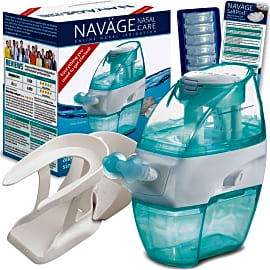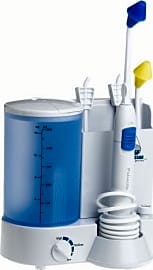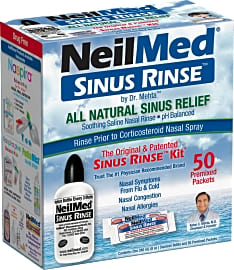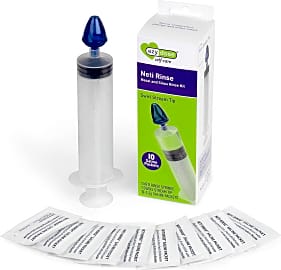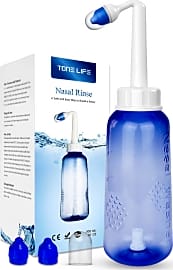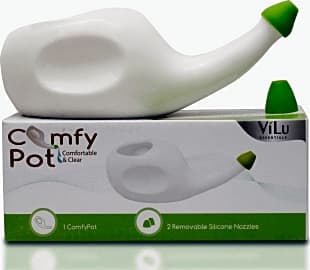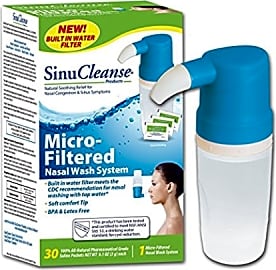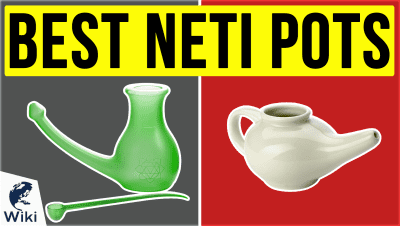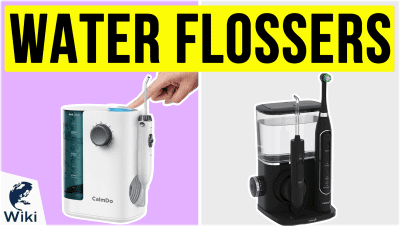The 10 Best Nasal Irrigators

This wiki has been updated 43 times since it was first published in April of 2016. Do you suffer from troublesome allergies? Or do you have a cold and want to relieve the symptoms without using drugs? Then one of these nasal irrigators may be perfect. Using saline-based solutions or gentle pulsations, they can clear out sinus passages almost instantly. These devices must be used with distilled or boiled water to avoid serious infection. Consult your doctor before using these. When users buy our independently chosen editorial selections, we may earn commissions to help fund the Wiki.
Editor's Notes
October 26, 2020:
We removed the Sanvic Pulsatile because it did not have enough power for many users and it had leaking issues. We replaced it with another powered unit, the ToiletTree Waterproof, which has three pressures – soft, normal, and pulse modes. Use the soft mode when you’re sick and your nose feels tender; otherwise use normal or pulse strength to thoroughly clean out your nasal passages.
We removed Dr. Natural Healing Care Kit because the bottle design was changed and it now has leaking issues. We replaced it with Ezy Dose Rinse, which uses a syringe to deliver a specific dosage of solution to your nasal passages. Be careful about using too much pressure because the excess fluid can travel into your ears and cause temporary discomfort. The syringe design comes apart and is easier to clean and use than a manual squeeze bottle or a neti pot.
It is important to note that serious infection can occur with any of these units if you do not follow all safety precautions in the manufacturer’s instructions. In addition to thoroughly reading and following all instructions and always using distilled or boiled water with these products, we recommend consulting with your doctor about safety issues before using one of these devices.
November 27, 2019:
Anybody currently dealing with a cold or who suffers from chronic allergies knows that stuffed nasal passages can really put a damper on your day. It makes food less enjoyable, makes it harder to concentrate, and just gives you a general feeling of discomfort. These nasal irrigators can help combat that by using a saline solution to clear out stubborn, thick mucus. If used regularly, they may also be able to help prevent colds, since they rinse bacteria out of your sinuses before they get a chance to make you sick. Before using any nasal irrigator though, it is vital that you read the instructions on your particular model and follow them exactly, including only using distilled or boiled water, or commercially-available saline solutions that are filtered and sanitized.
Nasal irrigators can generally be classified into three categories: gravity based, manual pressure based, and powered. Gravity-based models like the ComfyPot Neti simply require you to hold the pot higher than your nostril and the water naturally flows into one sinus and out the other, bringing mucus and bacteria along with it. The neti pot has been used in the United States since the early 70s and most likely for thousands of years in India.
Manual pressure-based options, like the Dr. Natural Healing Care Kit, Tonelife Nasal Wash Bottle, NeilMed Sinus Rinse, SinuCleanse Micro Filtered, and Nasaline Rinsing System allow you to adjust the strength of the flow by either squeezing a bottle or depressing a syringe of some kind. Many users may find these more effective than gravity-based pots since they can increase the pressure if needed.
Powered models, like the Health Solutions SinuPulse Elite Advanced, Grossan Hydro Pulse, Naväge Nose Cleaner, and Sanvic Pulsatile use a pump to push the water through your sinus, much like how a water flosser works. In the case of the Naväge Nose Cleaner there is also suction involved to really clear out thick mucus. These will generally also allow you to adjust the pressure as needed, but are limited by the settings on the machine.
Benefits Of Nasal Irrigators
In an allergic patient, the body produces histamines in response to average environmental components, such as pollen, dust, or perfume.
Using a nasal irrigator was once thought to be a drastic measure, only needed by people with severe allergies. The truth is, nasal irrigators can be seen as a form of preventative medicine for everyone, and are highly recommended in managing sinonasal conditions.
In a non-allergic patient, the body's normal allergic reaction is limited to large particles or especially irritant particles, such as inhaling black pepper. In an allergic patient, the body produces histamines in response to average environmental components, such as pollen, dust, or perfume. The body responds by swelling the mucous membranes to block off the sinuses. This results in the heavy, stuffed feeling most allergy sufferers describe. By introducing a saline solution into the sinuses, the contaminants which are causing the histamine reaction in the body are easily flushed out.
Nasal irrigators can be used for a variety of conditions. Treating acute and chronic rhinosinusitis, allergic and non allergic rhinitis, and nonspecific nasal symptoms like post-nasal drip is greatly influenced by the proper use of a nasal irrigator. In some cases, prescription medication can be reduced or eliminated while using a nasal irrigator.
Many studies have been brought forth showing the potential benefit of nasal irrigation in patients with issues such as allergic rhinitis and asthma. Results from these studies suggests that using a nasal irrigator on a daily basis can improve the daily symptoms of allergic rhinitis in many cases.
Using A Nasal Irrigator Properly
Part of the reason nasal irrigators remain underused is their relatively subjective method of application. In the past, preparing and applying saltwater rinses required a significant amount of time, so their use was limited to people who really need it. With complete nasal irrigation systems on the market today, it is easier than ever to practice.
The act of nasal irrigation usually involves the gentle introduction of a simple saline solution into the nasal cavity through one of the nostrils. The solution then travels through the sinuses, picking up bacteria and contaminants as it goes. The solution then exits the opposite nostril, leaving the sinuses clear and disinfected.
Another aspect to consider when choosing a nasal irrigator is the volume of liquid to be delivered.
The goal of nasal irrigation is to clean out the entire nose, mucous membranes, and sinuses. Not all irrigation techniques can achieve this comfortably, however. Doctors have been studying the best method for successful irrigation of the entire sinus system. Some methods show success at entering the nose, but due to gravity, are forced back out before reaching the sinuses. Positive pressure provided by nasal irrigation systems works best, and delivers a solution to the forehead and cheek sinuses.
Another aspect to consider when choosing a nasal irrigator is the volume of liquid to be delivered. Studies have shown that high volume irrigation is the most effective at distributing saline solution to the entire system. This can be achieved by purchasing a large volume nasal irrigator, or simply using a low volume system multiple times.
The head position of the patient also seems to have an impact on how much solution is delivered to the sinuses. Placing the head down during irrigation can help to rinse out the top of the nose and forehead sinus, while tilting the head to either side can promote more liquid reaching either cheekbone sinus.
It is equally important to make sure that the saline concentration in the irrigator is correct. Many irrigators provide guidelines to creating solution or even prepacked solutions, which remove a degree of error. The other important consideration is the sanitation of the unit itself. Bacteria can accumulate on the irrigation wand or in the tank itself. If these are not properly cleaned, this bacteria can travel into the nose and sinuses, potentially exacerbating the problem.
The History Of Nasal Irrigators
Thanks to the streamlined look of modern nasal irrigators, it can seem as though the practice is new. In reality, nasal irrigation has been around for thousands of years. The earliest record of nasal irrigation comes from the ancient Hindu practice of Ayurveda, whose roots are traced back to the Hindu Vedic texts. Jala-neti, as it is called in Hindu, was a part of the daily cleansing ritual of Vedic scholars. A simple form of nasal irrigation, sniffing water from a cupped hand and then blowing it back out of the nose, is a step in the cleansing process for Muslims as well.
By purifying the nose, one could purify the thoughts and reach a higher level of meditation.
The first mass-produced nasal irrigation was introduced in 1972, by a Swami who wanted his Western students to benefit from the act of cleansing the body for meditation and pranayama. It was believed that clear breathing led to clear thinking. By purifying the nose, one could purify the thoughts and reach a higher level of meditation. The popularity of nasal irrigators was cemented in the West after being featured on popular talk shows, and nasal irrigators have now become commonplace.
Doctors have only recently recognized the benefits of nasal irrigation on the sinuses thanks to a growing number of studies. Much research has supported the notion that irrigations are beneficial, safe, and subjectively useful to patients as well. They are gentle enough to be tolerated by children and effective enough to reduce even the most severe allergic rhinitis symptoms.


